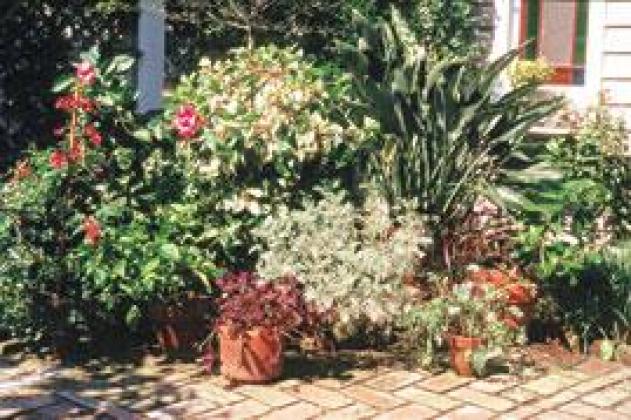
Dan Gill / LSU AgCenter Horticulturist
Louisiana gardeners often use containers of tender tropical plants on decks, patios and porches and in courtyards to provide color and beauty through the summer. These plants thrive in outdoor conditions, but because they cannot withstand freezing temperatures, they must be protected over the winter. Generally, this means bringing them indoors.
Before you start bringing them inside, decide which plants you really want to protect. You may have a few plants that are readily available and are relatively inexpensive to buy. It might not be worth the trouble to bring inside plants that are easily replaced. For those you will bring inside, look through your house and decide where they will be located. Remember, you must place these plants in or near windows or glass doors so they get plenty of light.
One of the most difficult problems these plants must deal with when brought inside is the sudden reduction in the amount of light they are accustomed to receiving. Plants use light as their source of energy to create the food they need to live and grow. When their light is suddenly and greatly reduced, it’s as if they were put on a starvation diet.
It is a good idea to move your outdoor tropicals to a heavily shaded outside location a couple of weeks before you move them indoors. Acclimating them to lower light conditions helps them adjust to the reduced light available in most homes when you bring them inside. The better you acclimate your plants and the more light you are able to provide for them indoors, the less leaf drop you should see.
Houseplants that spent the summer outside should also be groomed before you bring them in. This will help them look their best, and you will be less likely to bring in pests with the plants.
— Clean the outside of containers using a damp cloth or a brush and a mild solution of dishwashing liquid and water if needed. Do not get this solution in the soil.
— Remove dust and debris from the foliage and where leaves join the stems. Hose down the plants and wipe the foliage clean with a soft damp cloth.
— Remove all dead or yellow foliage, old flower stalks and dead or injured branches and stems.
— Do not repot immediately prior to moving plants indoors. Repotting should be done four to six weeks before bringing them inside. If this hasn’t been done, just wait until spring if they need repotting.
Once they are moved inside for winter, houseplants need to be watered less often. How much less water they need is something you will have to determine. Feel the soil regularly with your finger and water when the soil feels dry but before the plants wilt.
In time, you will establish a schedule for watering the plants indoors. Remember, it is better to water less often than to water too often and cause root rot. Cactuses and succulents are particularly vulnerable to overwatering, so be especially careful about not watering them too often.
During winter, water coming out of faucets indoors can be decidedly chilly. Tropical plants do not appreciate being watered with cold water, and in some cases it can even cause damage. (Cold water causes spots on African violet leaves.) When filling your watering can at the tap, mix hot water with the cold until the water temperature feels tepid or barely warm.
Generally, the plants you bring in for winter will not need to be fertilized this time of year. They will usually slow down or stop any new growth and enter a dormant or semi-dormant state. Indoor plants that show active, vigorous growth during the winter could be fertilized if desired.
Pest control
You should do a good, thorough job of pest control before you bring plants inside. Thoroughly clean all snails and slugs from the bottom of pots and dispose of them. Spray plants infested with aphids, spider mites, white flies, scale or thrips with a light horticultural oil spray. Spray thoroughly to coat all surfaces of the plant, including under the leaves. This also leaves a nice shine on the foliage.
Gardeners are sometimes surprised to find that ants have taken up residence in the soil of a container plant outside over the summer. Kill them before bringing the plant inside by drenching the soil with a solution of permethrin mixed according to label directions. If you do this for ants, it will also rid the soil of other undesirables such as earwigs, centipedes and grubs.
Be on the lookout for critters such as frogs, toads and lizards that may hitch a ride inside with the plants. These beneficial animals should be carefully removed and released outside unharmed.
